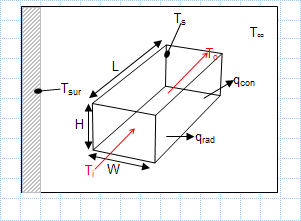Heat loss in duct.xls

Description
KNOWN: Dimensions, average surface temperature and emissivity of heating duct. Duct air inlet temperature and velocity. Temperature of ambient air and surroundings. Convection coefficient.
FIND: a) Heat loss from duct.
ASSUMPTIONS: 1) Steady-state conditions.
2) Constant air properties.
3) Negligible potential and kinetic energy changes of air flow.
4) Radiation exchange between a small surface and a large enclosure.
Calculation Reference
Fundamentals of Heat and Mass Transfer - Frank P. Incropera
To calculate the heat loss from a heating duct, we can consider the following steps:
-
Determine the surface area of the duct: Measure or calculate the surface area (A) of the duct that is exposed to the surroundings. This includes the outer surface area of the duct.
-
Determine the temperature difference: Calculate the temperature difference (ΔT) between the average surface temperature of the duct and the ambient air temperature. ΔT = T_duct - T_ambient.
-
Calculate the heat transfer coefficient: Determine the convective heat transfer coefficient (h) based on the conditions of the air flow around the duct. This coefficient depends on factors such as the air velocity, flow conditions, and surface characteristics. If the convective heat transfer coefficient (h) is given, proceed to the next step. Otherwise, consult relevant references or engineering data to estimate an appropriate value.
-
Calculate the heat loss: Use the following equation, known as Newton's Law of Cooling, to calculate the heat loss (Q):
Q = h * A * ΔT
Where: Q is the heat loss (in watts), h is the convective heat transfer coefficient (in watts per square meter-kelvin), A is the surface area of the duct (in square meters), ΔT is the temperature difference between the duct surface and the ambient air (in kelvin).
-
Account for radiation (if applicable): If radiation exchange between the duct and surroundings is significant, it needs to be considered in addition to the convective heat transfer. This involves incorporating the emissivity (ε) of the duct surface and the Stefan-Boltzmann Law. The equation for total heat loss (Q_total) considering both radiation and convection is:
Q_total = h * A * ΔT + ε * σ * A * (T_duct^4 - T_surroundings^4)
Where: Q_total is the total heat loss (in watts), ε is the emissivity of the duct surface (a dimensionless quantity between 0 and 1), σ is the Stefan-Boltzmann constant (5.67 x 10^-8 watts per square meter-kelvin^4), T_duct is the average surface temperature of the duct (in kelvin), T_surroundings is the temperature of the surroundings (in kelvin).
By utilizing these calculations, you can determine the heat loss from the heating duct, considering both convection and radiation effects.
Calculation Preview
Full download access to any calculation is available to users with a paid or awarded subscription (XLC Pro).
Subscriptions are free to contributors to the site, alternatively they can be purchased.
Click here for information on subscriptions.
